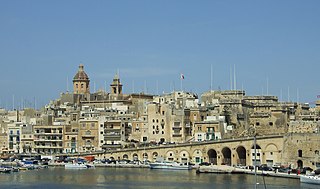
Birgu, also known by its title Città Vittoriosa, is an old fortified city on the south side of the Grand Harbour in the South Eastern Region of Malta. The city occupies a promontory of land with Fort Saint Angelo at its head and the city of Cospicua at its base. Birgu is ideally situated for safe anchorage, and over time it has developed a very long history with maritime, mercantile and military activities.

St John's Co-Cathedral is a Catholic co-cathedral in Valletta, Malta, dedicated to Saint John the Baptist. It was built by the Order of St. John between 1573 and 1578, having been commissioned by Grand Master Jean de la Cassière as the Conventual Church of Saint John.

Fort St. Angelo is a bastioned fort in Birgu, Malta, located at the centre of the Grand Harbour. It was originally built in the medieval period as a castle called the Castrum Maris. It was rebuilt by the Order of Saint John as a bastioned fort called Fort Saint Angelo between the 1530s and the 1560s, and it is best known for its role as the Order's headquarters during the Great Siege of Malta of 1565. A major reconstruction to designs of Carlos de Grunenbergh took place in the 1690s, giving the fort its current appearance.
The Three Cities is a collective description of the three fortified cities of Vittoriosa, Senglea and Cospicua in Malta. The oldest of the Three Cities is Vittoriosa, which has existed since prior to the Middle Ages. The other two cities, Senglea and Cospicua, were both founded by the Order of Saint John in the 16th and 17th centuries. The Three Cities are enclosed by the Cottonera Lines, along with several other fortifications. The term Cottonera is synonymous with the Three Cities, although it is sometimes taken to also include the nearby town of Kalkara.
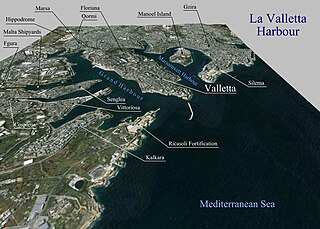
The Grand Harbour, also known as the Port of Marsa, is a natural harbour on the island of Malta. It has been substantially modified over the years with extensive docks, wharves, and fortifications.

Fra' Philippe de Villiers de L'Isle-Adam was a prominent member of the Knights Hospitaller at Rhodes and later Malta. Having risen to the position of Prior of the Langue of Auvergne, he was elected 44th Grand Master of the Order in 1521.
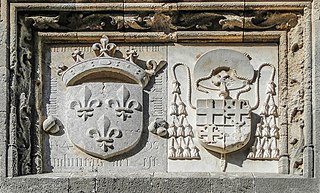
A langue or tongue was an administrative division of the Knights Hospitaller between 1319 and 1798. The term referred to a rough ethno-linguistic division of the geographical distribution of the Order's members and possessions. Each langue was subdivided into Priories or Grand Priories, Bailiwicks and Commanderies. Each langue had an auberge as its headquarters, some of which still survive in Rhodes, Birgu and Valletta.
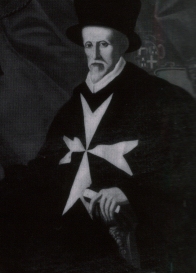
Fra' Juan de Homedes y Coscón was a Spanish knight of Aragon who served as the 47th Grand Master of the Order of Malta, between 1536 and 1553.

Fra' Piero del Ponte was the 45th Grand Master of the Order of Saint John between 1534 and 1535.
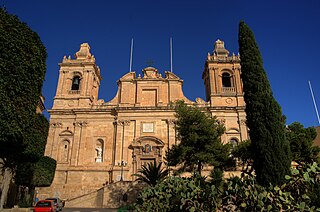
The Collegiate church of Saint Lawrence is an old Church situated in Birgu in Malta.

Hospitaller Malta, known in Maltese history as the Knights' Period, was a de facto state which existed between 1530 and 1798 when the Mediterranean islands of Malta and Gozo were ruled by the Order of St. John of Jerusalem. It was formally a vassal state of the Kingdom of Sicily, and it came into being when Emperor Charles V granted the islands as well as the city of Tripoli in modern Libya to the Order, following the latter's loss of Rhodes in 1522. Hospitaller Tripoli was lost to the Ottoman Empire in 1551, but an Ottoman attempt to take Malta in 1565 failed.

Auberge d'Angleterre is an auberge in Birgu, Malta. It was built around 1534 to house knights of the Order of Saint John from the langue of England. It now houses a health centre, and is the best-preserved Hospitaller auberge in Birgu.

Auberge de France is an auberge in Birgu, Malta. It was built around 1533 to house knights of the Order of Saint John from the langue of France, which induced the entire Kingdom of France except for Auvergne and Provence which were separate langues. The building housed the French langue until a new Auberge de France was opened in Valletta.

The fortifications of Malta consist of a number of walled cities, citadels, forts, towers, batteries, redoubts, entrenchments and pillboxes. The fortifications were built over hundreds of years, from around 1450 BC to the mid-20th century, and they are a result of the Maltese islands' strategic position and natural harbours, which have made them very desirable for various powers.
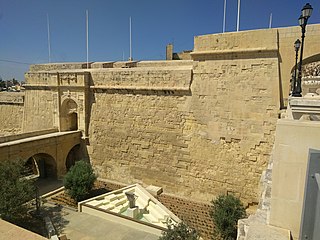
The fortifications of Birgu are a series of defensive walls and other fortifications which surround the city of Birgu, Malta. The first fortification to be built was Fort Saint Angelo in the Middle Ages, and the majority of the fortifications were built between the 16th and 18th centuries by the Order of Saint John. Most of the fortifications remain largely intact today.

The Birgu Clock Tower, also called the Vittoriosa Clock Tower and originally the Civic Clock Tower, was a clock tower in Birgu, Malta. It was located in Victory Square, the city's main square, and it was a prominent landmark in Birgu and the rest of the Three Cities. The tower was probably built in the Middle Ages, although some sources state that it was constructed in 1549. It served as a watchtower since it had views over the Grand Harbour and the surrounding countryside, and it saw use during the Great Siege of Malta in 1565. A clock was installed in the tower in the 17th century.

The Slaves' Prison officially known as the Grand Prison and colloquially as the bagnio, was a prison in Valletta, Malta. It was established in the late 16th century, and remained in use as a prison throughout the 17th and 18th centuries. It was subsequently used as a naval hospital, a school and an examination hall. It was bombed in World War II, and the ruins were demolished to make way for a block of flats.

On 18 July 1806, approximately 40,000 lb (18,000 kg) of gunpowder stored in a magazine (polverista) in Birgu, Malta, mistakenly detonated. The explosion killed an estimated 200 people, including British and Maltese military personnel, and Maltese civilians from Birgu. Parts of the city's fortifications, some naval stores, and many houses were destroyed. The accident was found to be the result of negligence while transferring shells from the magazine.

The Church of the Nativity of Mary is a Roman Catholic church located within the historical Fort St. Angelo, in Birgu, Malta.

The Chapel of St Anne is a Roman Catholic chapel located in Fort Saint Elmo in Valletta, Malta. Its existence was first documented in the late 15th century, and it was incorporated into the fort when the latter was constructed by the Order of St John in the mid-16th century. The chapel's present state dates back to the mid-17th century.























